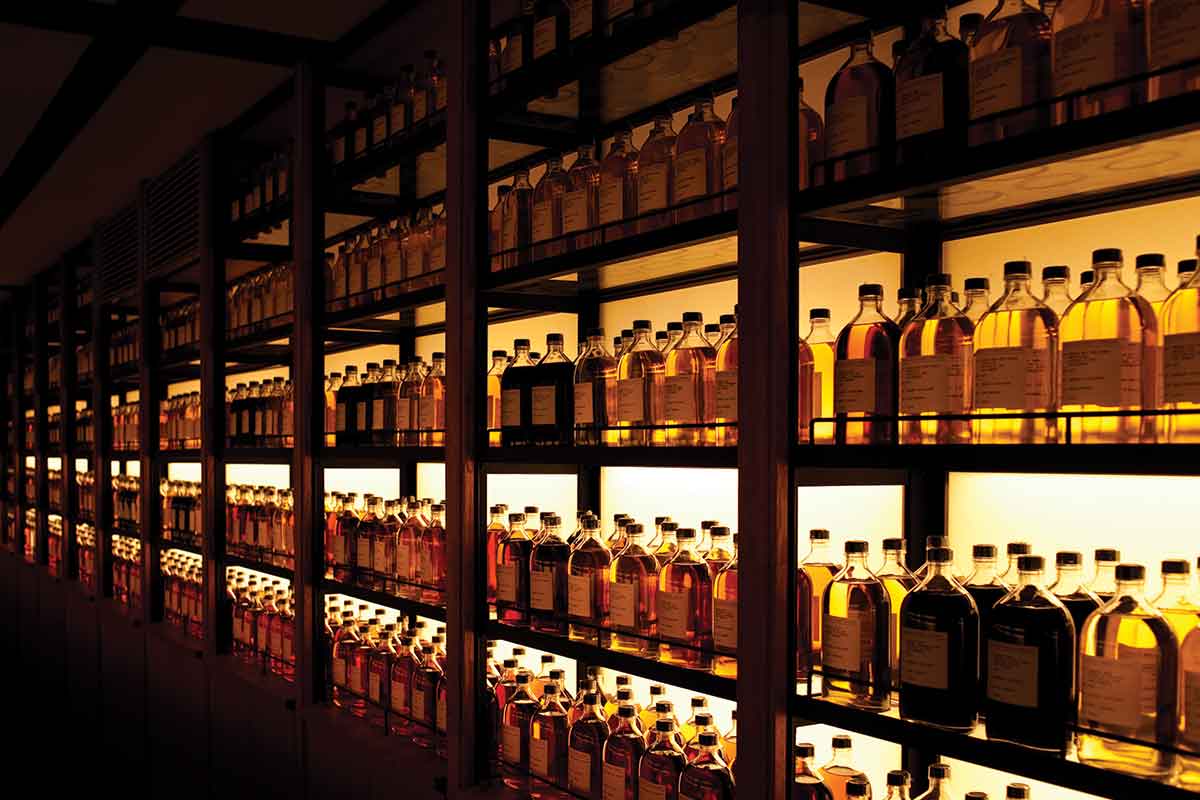Many beginner Scotch whisky drinkers get hung up on the country’s regions — which are useful as guides, though the styles aren’t as rigidly defined as some think. However, the most important rules to know are the differences between single malt and blended whisky. In fact, there are actually five Scotch whisky categories, each one with either single or blended in its title. But each of them are mutually exclusive so that a particular whisky can only be classified one way.
On the surface it may also seem easier to think of single malt vs. blended whisky as being the main classification system. However, another outlook might be even more logical. When looking at the whole of Scotch whisky, compare single malt to single grain whiskies. These are not only distinct whisky categories, but they’re also the only possible components used in any Scotch whisky blend. Therefore, all Scotch whisky comprises of a) single malt whisky b) single grain whisky or c) some combination of one or both of those. Let’s start there.

Single Malt Scotch Whisky
Single malt Scotch whisky is made in Scotland from malted barley as its only grain. Also, it must be produced at a single distillery using batch distillation via pot stills. The pot stills are required, but double distillation isn’t. There are notable outliers there, such as Auchentoshan, which follows a triple pot distillation regimen.
As all single malt must be pot distilled, and can by definition only come from one place, the pot stills used by a particular distillery are of the utmost importance. Indeed the shape and size of pot stills serve as the key drivers of flavor and differentiation for one distillery versus another. From bulbous and stout to tall and narrow, pot stills are both hugely variable and hugely important.
The major single malts likely need no introduction. Think about names such as Balvenie, Macallan, Glenfiddich, Glenlivet and Glenmorangie. Or if you like peated whiskies, the Islay mainstays of Lagavulin, Laphroaig and Bowmore are sure to ring a bell.
Single Grain Whisky
The phrase single grain whisky is sometimes misunderstood, because it seems to be indicating a whisky made from, well, a single grain. However, the opposite is true. Single grain whisky is made using malted barley in addition to other malted or unmalted cereal grains. As with single malts, the use of “single” here refers instead to production taking place at a single distillery.
Single grains are not legally bound to be column distilled, but they essentially always are. The ratio of malted barley to other grains, and the types of other grains which are used, are not regulated. Generally though, malted barley is a minority player at 20% or less of a single grain’s mash bill. Corn and wheat are the most common additional grains used.
Grain whisky is often seen as bulk fodder for the major blends. However, single grains that get to market can be quite tasty in their own rights. These whiskies present different flavors from malts and often have a creamier mouthfeel. And because demand for them has been historically low, there are often good values on well-aged expressions. Think about the Girvan 25 Year or the occasional grain whisky in Diageo’s annual special releases, such as those from Cambus. You can also look for independent bottlings from distilleries such as Port Dundas, Invergordon, or Strathclyde.

Three Types of Blended Whisky
Now that single malts and single grains are explained, we can cover the three types of blends in Scotch whisky. First, a blended malt is a blend of two or more single malts. Next, a blended grain is a blend of two or more single grains. And finally, blended whisky is therefore any combination of at least one single malt whisky with at least one single grain whisky.
While it sometimes seems like the big single malt brands dominate the Scotch whisky world, looking at sales rather than trends or headlines tells a different story. According to the Scotch Whisky Association, single malts account for just 10% of exports, with blended whisky being the true king of the jungle, with a 68% share. Single grain, blended grain and blended malt whiskies fill in the remaining 22% combined.
Monkey Shoulder is a notable blended malt, while Compass Box is a leader of the modern blended grain whisky category. As for blended whisky, well, you don’t have to think too hard about these: Johnnie Walker, Chivas Regal, Grant’s, Ballantine’s, Dewar’s and Famous Grouse are just a few of the mega-brands in the category.
What remains the same — whether it’s a single malt, a blended whisky, or any of the other options — is that Scotch whisky has to meet certain category-wide requirements. The list includes: being matured in Scotland for a minimum of three years in oak casks 700-liters or smaller; being distilled at a maximum 94.8% ABV; and being bottled at a minimum of 40% ABV. Caramel coloring is also very much allowed to be used.
Want to learn more about single malt and blended Scotch whisky?
With Distiller, you’ll always know what’s in the bottle before you spend a cent. Rate, Review, and Discover spirits. Head on over to Distiller, or download the app for iOS and Android today!
Want to enjoy Distiller ad-free plus exclusive discounts, giveaways, features and other perks? Join Distiller Pro today to support the Distiller platform and keep ads off of your screen.


